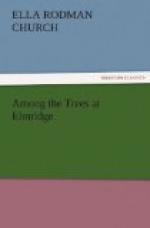“And what is vulcanite?” asked Clara.
“It is caoutchouc mixed with sulphur. Unless a small quantity of brimstone is added in the manufacture of overshoes, they become soft when exposed to heat and hardened when exposed to cold; but it was discovered that the sulphur will keep them from being affected by changes in temperature. When a large amount of sulphur is used, the India-rubber, becomes as hard as horn or wood, and this is the substance called vulcanite. Now the gum is imported in masses, to be wrought over by our skillful mechanics.”
The children were very much pleased to find that they had learned the nature of three important articles—India-rubber, gutta-percha and vulcanite—and they thought it would be quite easy to remember the differences between them.
“And now,” said Miss Harson, “the last of these useful trees—the cow tree, or milk tree—is the most curious one of all. Like the caoutchouc, it is a native of South America; but the sap is a rich fluid that answers for food, like milk. It is a fine-looking tree with oblong, pointed leaves about ten inches in length and a fleshy fruit containing one or two nuts. The sap is the most valuable part; and when incisions are made in the trunk of the tree, there is an abundant flow of thick milk-like sap, which is described as having an agreeable and balmv smell. The German traveler Humboldt drank it from the shell of a calabash, and the natives dip their bread of maize or cassava in it. This milk is said to be very fattening; and when exposed to the air, it thickens into a substance which the people call cheese.”
“Milk and cheese from a tree!” exclaimed Malcolm. “Do you think we’d like them as well as ours, Miss Harson?”
“No,” was the reply, “I do not think we should; but if we had never known any other kind, it would be quite a different matter, and the traveler says that both smell and taste are agreeable. The sap, it seems, is like curdled milk, and the natives say that they can tell, from the thickness and color of the foliage, the trunks that yield the most juice. This wonderful tree will be found growing on the side of a barren rock, and its large, woody roots can scarcely penetrate into the stone. For several months of the year not a single shower moistens its foliage. Its branches then appear dead and dried; but when the trunk is pierced, there flows from it a sweet and nourishing milk. It is at the rising of the sun that this vegetable fountain is most abundant. The negroes and natives are then seen hastening from all quarters, furnished with large bowls to receive the milk, which grows yellow and thickens at its surface. Some empty their bowls while under the tree itself; others carry the juice home to their children.”
“Isn’t it funny,” said Edith, laughing, “to go and get their breakfasts from a tree? I wish we had some milk trees here.”
“But you would not find it pleasant,” replied their governess, “to have some other things that are always found where the milk tree grows. The intense heat and the swarms of mosquitoes and biting flies, the serpents and jaguars and other disagreeable and dangerous creatures, make life in that region anything but pleasant, and the curious vegetation and delicious fruits are not worth the suffering inflicted by all these torments.”




